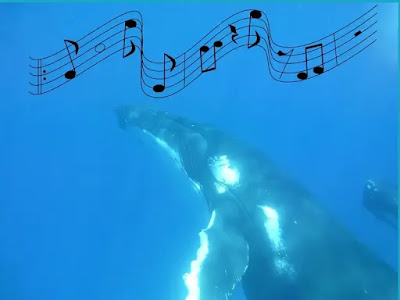Whale songs are a fascinating and important aspect of marine biology. These songs are unique to each species of whale, and they play an important role in communication and social behavior.
Whale songs have been the subject of scientific research for several decades, but there is still much we do not know about these complex vocalizations. In this article, we will explore the world of whale songs, focusing on the haunting melodies of humpback whales and the science behind these beautiful songs.
Whale songs are a critical aspect of whale behavior, and they have several important functions. For example, they are used for communication, allowing whales to share information about food sources, mating opportunities, and potential threats. They are also used for navigation and to attract mates.
It is important to note that human activities, such as noise pollution and overfishing, can have a significant impact on whale songs and their ability to communicate effectively. By studying whale songs, scientists can gain a better understanding of these magnificent creatures and work to protect them from threats caused by human activity.
The purpose of this article is to provide a comprehensive overview of whale songs and their significance. We will start by exploring what whale songs are and the different types of whale songs that exist. Then, we will dive into the science behind whale songs and the different theories about why whales sing. We will also discuss the significance of whale songs and their cultural importance in various indigenous cultures. Finally, we will look at future research and the potential for technological advancements in whale song research.
I. What are whale songs?
Whale songs are unique vocalizations made by different species of whales. They are a complex series of sounds produced by whales in order to communicate with each other, and they are an important aspect of whale behavior.
Whale songs are a specialized form of communication that is specific to each species of whale. While some whales produce simple calls or clicks, others, like humpback whales, produce long, complex songs. These songs can be heard over long distances and can last for hours at a time.
There are several different types of whale songs, including "songs" (long, complex vocalizations), "calls" (shorter, simpler vocalizations), and "clicks" (used for echolocation). Different species of whales make different types of vocalizations. For example, humpback whales are known for their long, complex songs, while blue whales produce low-frequency calls.
Whales produce sounds by forcing air through specialized air sacs in their bodies. The sounds are then modified by structures in the whale's head, producing the distinct vocalizations associated with different species of whales. The complexity of whale songs is truly remarkable, with some songs consisting of hundreds or even thousands of individual sounds.
Interestingly, different populations of whales produce different songs, and these songs can change over time. This means that even within the same species, different populations of whales may have distinct vocalizations. For example, humpback whales in different parts of the world have been found to produce different songs.
Whale songs have been the subject of scientific research for several decades, and there is still much we do not know about these complex vocalizations. By studying whale songs, scientists can gain a better understanding of these magnificent creatures and their behavior.
II. The science behind whale songs
Whale songs have captivated scientists for decades, and research has revealed a great deal about the origins and significance of these vocalizations. Here are some key points about the science behind whale songs:
1. Research on the origins of whale songs
The study of whale songs began in earnest in the 1960s, with the first recordings of humpback whale songs. Since then, advances in recording technology have made it easier for scientists to study whale songs in their natural habitat. Today, researchers use a variety of tools, including hydrophones and drones, to record and analyze whale songs.
Studying captive whales has also been a valuable tool in understanding the mechanisms behind vocalizations. For example, scientists have discovered that whales produce sounds by forcing air through their vocal cords, which vibrate to produce sound waves. They have also learned that different species of whales have different vocal cords and produce different types of vocalizations.
2. Theories about why whales sing
While much is still unknown about why whales sing, several theories have emerged:
Communication: The most widely accepted theory is that whale songs are a form of communication between individuals or groups of whales. Whales use these vocalizations to coordinate social behavior and find mates. For example, humpback whales sing complex songs during the breeding season, which may help males attract mates.
Mating: Some scientists believe that male whales sing to attract mates during the breeding season. Researchers have found that the songs of male whales can change over time, suggesting that they are refining their vocalizations in order to be more successful in attracting mates.
Social behavior: Other researchers suggest that whale songs play a role in social behavior, such as establishing social hierarchies or maintaining group cohesion.
3. The role of genetics and evolution
Recent research has suggested that there may be a genetic basis for whale songs, with certain vocalizations being passed down through generations. This raises the possibility that whale songs are an important aspect of whale culture, with distinct populations of whales developing their own unique vocalizations.
Scientists also believe that whale songs may have played a role in the evolution of whales. For example, some researchers suggest that the evolution of complex vocalizations allowed whales to coordinate social behavior more effectively, which in turn may have led to the development of larger, more complex social structures.
4. The significance of whale songs
Whale songs are a critical form of communication among whales, allowing them to coordinate social behavior and find mates. However, they also have broader significance:
- Conservation: Studying whale songs can provide important information for conservation efforts. Changes in vocalizations can signal changes in whale populations, such as changes in the number of individuals or shifts in migration patterns. This information can be used to inform conservation efforts, such as efforts to reduce human impacts on whale habitats.
- Cultural significance: Whale songs have cultural significance in many indigenous cultures around the world. For example, the songs of humpback whales are an important part of Hawaiian and Polynesian culture, where they are believed to be a form of spiritual communication.
III. The significance of whale songs
Whale songs are not just fascinating from a scientific standpoint – they also play a critical role in the lives of whales and the ecosystems in which they live. Here are some key points about the significance of whale songs:
1. How whale songs are used for communication
Whale songs are a crucial form of communication among whales, allowing them to coordinate social behavior and find mates. For example:
- Breeding: During the breeding season, male humpback whales sing complex songs to attract females. These songs can last for hours and are incredibly intricate, with each population of humpback whales having its own unique song.
- Navigation: Some whales, such as beluga whales, use echolocation to navigate and find food. Echolocation involves emitting a series of clicks or sounds and then listening for the echoes that bounce back off nearby objects. By analyzing these echoes, whales can determine the location and distance of objects in their environment.
- Social behavior: Whales also use vocalizations to establish social hierarchies and maintain group cohesion. For example, researchers have observed that sperm whales use a series of clicks and whistles to communicate with each other during foraging trips, with different types of clicks and whistles indicating different types of behavior.
2. The impact of human activities on whale songs
Unfortunately, human activities have had a significant impact on whale populations and their vocalizations. Here are some ways in which human activities have affected whale songs:
- Noise pollution: Human activities such as shipping and oil exploration can create significant amounts of noise in the ocean, which can disrupt whale communication. For example, loud ship engines can interfere with whale vocalizations, making it harder for whales to communicate with each other and find mates.
- Climate change: Climate change is also affecting whale populations, with changes in ocean temperatures and currents affecting their distribution and migration patterns. This in turn can impact their vocalizations, as changes in population dynamics can lead to changes in the structure and content of whale songs.
- Hunting: Whaling has historically been a major threat to many whale populations, and continues to be a problem in some parts of the world. Hunting can impact whale vocalizations by reducing the number of individuals in a population, which can lead to changes in social behavior and vocalization patterns.
3. The importance of whale songs for conservation
Studying whale songs can provide important information for conservation efforts. For example:
- Population dynamics: Changes in whale vocalizations can provide valuable information about changes in whale populations, such as shifts in migration patterns or changes in the number of individuals in a population.
- Habitat preservation: Understanding the vocalization patterns of whales can help identify important habitats and migration routes, which can be protected through marine conservation efforts.
- Monitoring: By monitoring whale vocalizations over time, researchers can gain a better understanding of changes in whale behavior and population dynamics. This information can be used to inform conservation efforts and track the effectiveness of conservation measures.
Overall, whale songs are a critical aspect of whale behavior and communication, and play a significant role in the health of marine ecosystems. By studying and protecting these vocalizations, we can deepen our understanding of these magnificent creatures and work to preserve them for future generations.
IV. The mystery of humpback whale songs
Of all the whale species, humpback whales are perhaps the most well-known for their vocalizations. Here are some key points about the mysterious and haunting melodies of humpback whale songs:
1. The haunting melodies of humpback whales
Humpback whale songs are perhaps the most famous of all whale vocalizations, thanks in part to their complex and haunting melodies. Here are some key facts about humpback whale songs:
- Complexity: Humpback whale songs are incredibly complex, with each song consisting of a series of themes or phrases that can last for several minutes.
- Uniqueness: Each population of humpback whales has its own unique song, which evolves slowly over time. This means that humpback whale songs can vary significantly from one population to another.
- Longevity: Humpback whale songs can last for hours, with individual whales singing the same song for hours on end.
2. Theories about why humpback whales sing
Despite years of research, scientists are still unsure why humpback whales sing. Here are some of the leading theories:
- Mating: One of the most commonly accepted theories is that male humpback whales sing to attract females during the breeding season. This theory is supported by observations of males singing while they are alone or in the presence of females.
- Social behavior: Another theory is that humpback whales sing to establish social hierarchies or to maintain group cohesion. For example, researchers have observed that humpback whales tend to sing more when they are in larger groups.
- Navigation: Some researchers believe that humpback whales use vocalizations to navigate and find food. This theory is supported by observations of humpback whales making different types of vocalizations when they are foraging or in the presence of prey.
3. The evolution of humpback whale songs
While the reasons for humpback whale songs are still unclear, researchers have made significant strides in understanding the evolution of these vocalizations. Here are some key points:
- Origins: Humpback whale songs are thought to have evolved around 10 million years ago, and are believed to have originated as a form of communication between mothers and calves.
- Evolution: Over time, humpback whale songs evolved to become more complex, possibly as a result of sexual selection. In other words, females may have preferred males with more complex songs, leading to the evolution of more intricate vocalizations over time.
- Cultural transmission: Humpback whale songs are also believed to be culturally transmitted, meaning that young whales learn their songs from older individuals in their population. This can lead to the development of unique song patterns within different populations of humpback whales.
V. The cultural significance of whale songs
Whale songs have played an important role in the cultural traditions of many indigenous communities around the world. Here are some key points about the cultural significance of whale songs:
1. The role of whale songs in indigenous cultures
Whales have long been revered by many indigenous communities around the world, who view them as powerful and spiritually significant creatures. Here are some examples of the role that whale songs have played in indigenous cultures:
- Inuit communities in the Arctic have long relied on whales as a vital source of food and materials, and have developed a rich cultural tradition around these animals. Inuit hunters have long used songs and vocalizations to communicate with whales during hunts, and believe that their songs are a way of showing respect for the animals they hunt.
- In Hawaii, humpback whale songs have played an important role in the cultural traditions of native Hawaiians. According to Hawaiian mythology, the god Kanaloa was said to have control over the ocean and all the creatures in it, including the whales. Hawaiian chanters and musicians have long incorporated whale songs into their performances, using them as a way to connect with the natural world and honor their cultural heritage.
- In many indigenous communities in Australia, whales are viewed as ancestral beings that have played a significant role in the creation of the natural world. Whale songs and vocalizations are believed to be a way of connecting with these ancestral beings and maintaining a connection to traditional culture.
2. The use of whale songs in art and music
Whale songs have also played an important role in the world of art and music. Here are some examples of how artists and musicians have used whale songs as inspiration:
- Many contemporary artists have drawn inspiration from the haunting melodies of humpback whale songs, incorporating them into their music, films, and other forms of artistic expression. For example, the composer and musician Paul Winter has long been inspired by whale songs, and has incorporated recordings of these vocalizations into many of his works.
- Whale songs have also been the subject of numerous scientific studies, as researchers seek to better understand the significance of these vocalizations. For example, in the 1960s and 1970s, researchers at the Woods Hole Oceanographic Institution used underwater microphones to record the songs of humpback whales in the Caribbean, helping to pave the way for further research into these vocalizations.
3. The conservation of whale songs
In addition to their cultural and artistic significance, whale songs have also become an important focus of conservation efforts in recent years. As human activities such as shipping, oil exploration, and commercial fishing continue to put pressure on marine ecosystems, there is growing concern about the impact of these activities on the ability of whales to communicate with one another.
In response, researchers and conservationists have been working to better understand the vocalizations of different whale species, and to develop strategies for minimizing the impact of human activities on these vocalizations. For example, some researchers are exploring the use of quieter shipping technologies that are less likely to interfere with whale songs, while others are developing new technologies for monitoring whale vocalizations in real time.
By better understanding the significance of whale songs and working to protect these vocalizations, we can help to ensure that these majestic creatures continue to thrive for generations to come.
4. The future of whale song research
As technology continues to advance, there is great potential for further research into the fascinating world of whale songs. Some of the areas of future research could include:
- Exploring the role of social learning in the development of whale songs: While it is known that whale songs are learned from other individuals within their social groups, there is still much to learn about how this process works and how it affects the evolution of whale songs over time.
- Investigating the impact of anthropogenic noise on whale vocalizations: As human activities continue to produce increasing levels of underwater noise, it is important to understand how this noise affects the ability of whales to communicate with one another, and how we can work to mitigate this impact.
- Developing new technologies for monitoring whale vocalizations: Advances in underwater microphones and other monitoring technologies are opening up new possibilities for researchers to study whale songs in real time, allowing for a more detailed understanding of how these vocalizations are used in communication.
- Examining the use of whale songs in other whale species: While humpback whales are perhaps the most well-known for their elaborate songs, many other whale species also produce vocalizations that are thought to play important roles in communication. Further research into these vocalizations could help to expand our understanding of the complex social lives of whales.
VI. Future research
The world of whale songs is a constantly evolving field of study, and there are many areas for future research and exploration. Some of the key areas of focus for future research include:
- Understanding the evolution of whale songs: While much is known about the vocalizations of different whale species, there is still much to learn about how these vocalizations have evolved over time. Researchers are interested in understanding how the different calls and sounds that make up whale songs have developed and diverged over evolutionary time. By studying the vocalizations of different whale populations and comparing them to one another, researchers can gain new insights into the evolutionary history of these fascinating creatures.
- Investigating the impact of climate change on whale songs: As climate change continues to alter marine ecosystems around the world, it is important to understand how these changes are affecting the vocalizations of whales. Changes in ocean temperature, acidity, and currents can have a significant impact on the acoustic environment in which whales live, and can alter the way that sound travels through the water. These changes can make it difficult for whales to communicate with one another, which can have serious implications for their social lives and survival. By studying the vocalizations of different whale populations over time, researchers can gain new insights into how climate change is affecting the social lives and survival of these creatures.
- Developing new technologies for studying whale songs: Advances in underwater microphones and other monitoring technologies are opening up new possibilities for studying whale songs in real-time. These tools are allowing researchers to gain a more detailed understanding of how whales use sound to communicate, and are providing insights into the role that whale songs play in different aspects of whale behavior. For example, researchers are using these tools to study the ways in which humpback whales use songs to coordinate their feeding behaviors.
- Examining the cultural significance of whale songs: While much is known about the scientific significance of whale songs, there is still much to learn about the cultural significance of these vocalizations. Throughout history, whale songs have played an important role in the cultures of many indigenous communities around the world. For example, the Inuit people of the Arctic have long believed that the songs of the whales are a form of communication between humans and the divine. By studying the role of whale songs in different cultural contexts around the world, researchers can gain new insights into the ways in which these vocalizations have shaped human cultures over time.
- Studying the functional significance of different parts of whale songs: While much is known about the overall structure and patterns of different whale songs, there is still much to learn about the functional significance of different parts of these vocalizations. For example, researchers are interested in understanding the role that different types of calls play in whale communication, and how these calls might vary depending on the social context in which they are used. By gaining a more detailed understanding of the functional significance of different parts of whale songs, researchers can gain new insights into the ways in which these vocalizations are used in communication.
As research into the world of whale songs continues to evolve, it is likely that we will gain new insights into the remarkable complexity and significance of these vocalizations. By studying and protecting these vocalizations, we can help to ensure that these magnificent creatures continue to thrive for generations to come.
👉 Read more posts with the same topic
VII. Conclusion
In conclusion, whale songs are a complex and fascinating topic that holds great scientific and cultural significance. From their communication functions to their role in indigenous cultures, whale songs have captured the imagination of people around the world. Despite ongoing research and technological advancements, much remains to be discovered about the intricacies of these vocalizations and their importance to whale populations.
As humans, it is our responsibility to ensure the survival and well-being of these magnificent creatures. By studying and protecting their vocalizations, we can help to ensure that whale populations continue to thrive and contribute to the diversity and beauty of our planet.
Overall, the world of whale songs serves as a reminder of the remarkable complexity and diversity of life on Earth, and the importance of preserving and protecting it for generations to come.
VIII. References
- Clark, C. W., & Ellison, W. T. (2004). Context-dependent acoustic cues for individual recognition in humpback whales (Megaptera novaeangliae). Animal behaviour, 67(2), 301-310.
- McDonald, M. A., Mesnick, S. L., & Hildebrand, J. A. (2006). Biogeographic characterization of blue whale song worldwide: using song to identify populations. Journal of Cetacean Research and Management, 8(1), 55-65.
- Payne, R. S., & McVay, S. (1971). Songs of humpback whales. Science, 173(3997), 585-597.
- Tyack, P. L. (2008). Implications for marine mammals of large-scale changes in the marine acoustic environment. Journal of Mammalogy, 89(3), 549-558.
- Whitehead, H. (2003). Sperm whale vocal clans. Nature, 422(6932), 23.
- Würsig, B., & Würsig, M. (1977). The photographic determination of group size, composition, and stability of coastal porpoises (Tursiops truncatus). Science, 198(4317), 755-756.










0 Comments